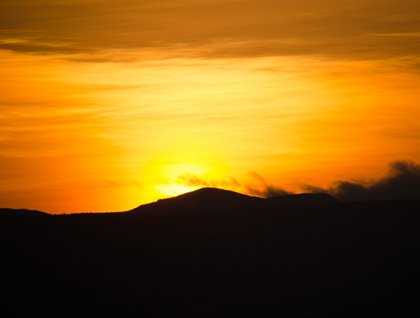Today turned out to be the day of the unexpected.
As first light appeared on the eastern sky, National Geographic Endeavour sailed the tranquil waters off Banks Bay on the Western side of Albemarle Island, officially known nowadays as Isabela. The orange light show made the strange volcanic landscape even more remarkable, but the true reward for the early birds would be a group of common dolphins which we encountered during a moment of surprising acrobatic display. After the good news of our encounter was spread to the remaining guests by our expedition leader, all guests had a chance to enjoy the sight of our athletic visitors.
Just as breakfast had been announced and most of us made our way to the dining room, one of our guests spotted yet another much smaller pod. This would turn out to be a sighting of one of the rarest marine mammals to be observed in the Galapagos Archipelago, the magnificent Orca. During the next moments we would have excellent opportunities to have a look at the small pod composed of a large male with his spade-like dorsal fin and three smaller females or juvenile males and a calf. As we looked on from the distance in amazement, the Orca pod continued on its northern course having given us excellent opportunities to photograph every animal so that these pictures can be passed on to researchers that are putting together a catalog of all animals spotted in the Galapagos.
After such an awesome start to yet another day we landed on Fernandina Island’s Punta Espinoza visitor site. This is only area open to any visitors on the third largest island of the Archipelago. Despite rapidly increasing tropical heat, we made our way across the smooth Pahoe-hoe lava flows to see the only flightless cormorant in the world and large numbers of Galapagos marine iguanas.
Once back on the ship we took a short moment to cool down with a quick swim from the loading bay of our ship before heaving anchor once again to cross back over the deep waters of the western side of Isabela to reach Punta Vicente Roca at the virtual chin of the imaginary sea horse that Isabela Island resembles on a map.
At Punta Vicente Roca we would explore the coastal environment form both underwater while snorkeling and from the surface thanks to our Zodiacs and their skilled drivers.
The area showed itself rich in wildlife as noddies, boobies and frigate birds perched on the rocky outcrops of the cliffs while flightless cormorants and Galapagos fur seals littered the coast line.
Underwater the panorama was even more active as school after school of tiny fish hugged the coast line as sea lions and cormorants briefly broke the surface to breathe before diving back into the deep after their prey. A shallow bay seemed the preferred resting area for Pacific green sea turtles and playful Galapagos sea lion pups frolicked in the shallows.
As sunset drew near, National Geographic Endeavour made its way a few miles to the north to say farewell the sun as we crossed the Equator. While enjoying a wine tasting on the bow of the ship, the view of yet another massive pod of common dolphins seemed a bit like a “Deja-vu.” What a day!







